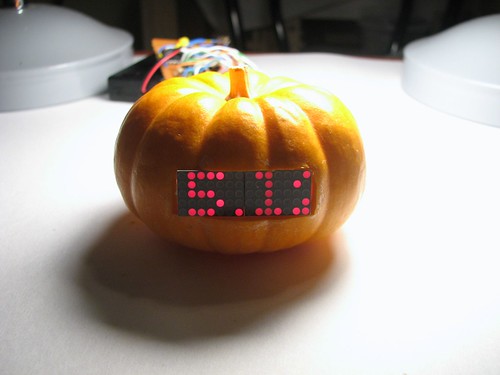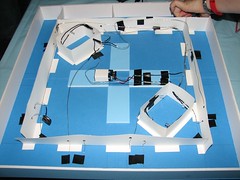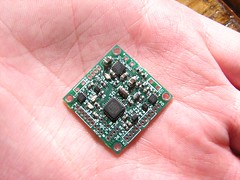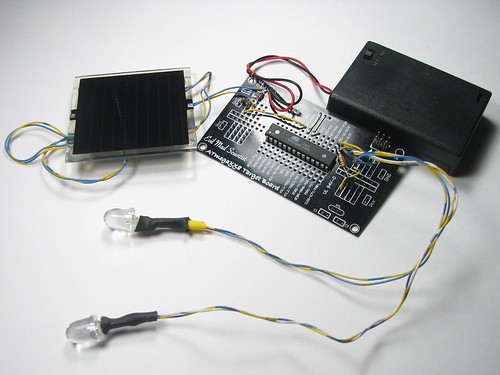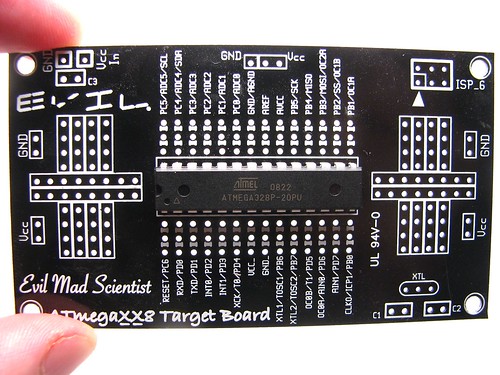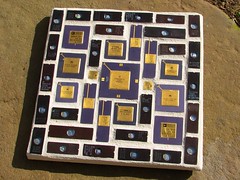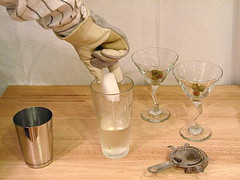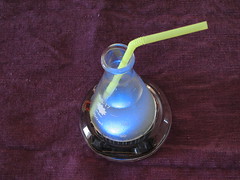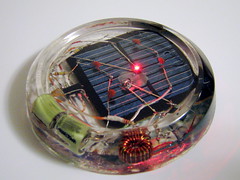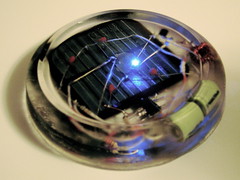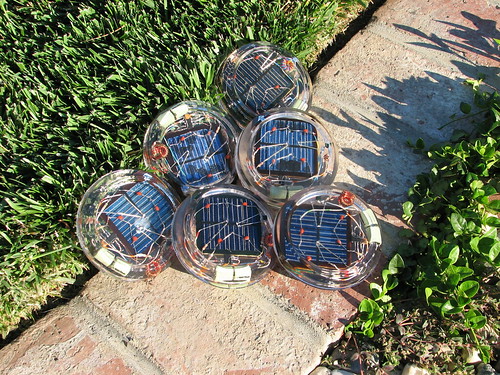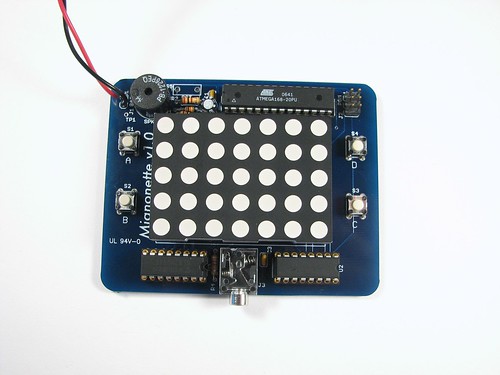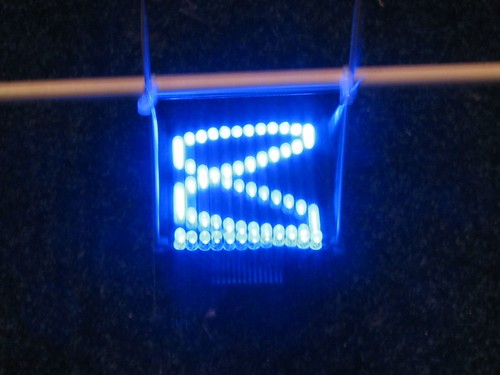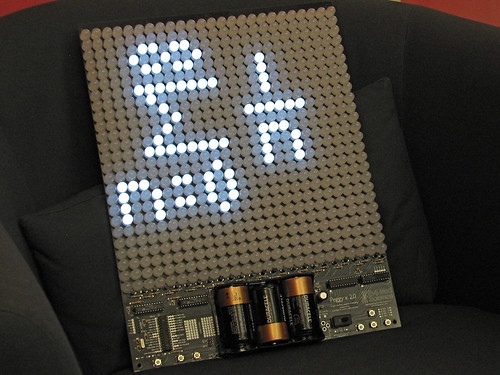Jack-o’-Lanterns are supposed to be scary, right? So here is our new one: it’s a mini pumpkin with a (tiny) scrolling LED stock ticker. Reprogrammable so you can update it every day with gloomy news from Wall Street.
Continue reading Scariest Jack-o’-Lantern of 2008
Category Archives: Engineering
Maker Faire Austin Pictures
We had a wonderful time at Maker Faire Austin. I’ve put some pictures and videos up in this flickr set for your enjoyment.
Our neighbors at Maker Faire were Kris and Carly who were doing very fun things with LEDs, like making Monopoly more fun by lighting up when you land on certain squares. The no-solder wiring system was very clever, and the flashing blue and red lights in jail were perfect.
This cute little robotics platform stopped by for a visit, but in order to see most of the rest of the faire we had to pry ourselves away from our table, which was tough. There was a nice collection of art cars, including this Chia Car. Maker Faire is wonderfully overwhelming, and we didn’t take very many pictures. Luckily, many other people took pictures too, and you can check lots of them out on flickr.
Simple Solar Circuits
Simple Solar Circuits:
How to get started adding solar power to your small electronics projects. Use the sun to power small solar and battery powered night lights, garden lights, and decorations for halloween.
Continue reading Simple Solar Circuits
A dark detecting circuit for your jack-o’-lantern
Here’s an inexpensive electronic circuit that you can build to put in your Jack-o’lantern. It provides power to drive a few LEDs at night, and automatically turns them off during the daytime. It’s a simple and automatic dark-detecting circuit that you can use to for your very own photosensitive pumpkin.
Continue reading A dark detecting circuit for your jack-o’-lantern
ATmega328 in the wild
This will be interesting to a small subset of our readers, but we’re finally seeing ATmega328P chips in the wild. This is a new chip from Atmel that is nearly identical to– but with twice the memory of– the popular ATmega168 microcontroller, the microcontroller in the Arduino and in our (Arduino-compatible) Peggy 2.0. They are still in short supply, but they’ll be a lot of fun to play with. :)
In the photo is one of these on one of our “business card” AVR target boards that we designed for the ATmega48, ’88, ‘168, and ‘328, so it’s finally lived up to its name.
The Hungry Scientist Handbook
 Today is the official release date for the Hungry Scientist Handbook, a new book by Patrick Buckley and Lily Binns.
Today is the official release date for the Hungry Scientist Handbook, a new book by Patrick Buckley and Lily Binns.
The Hungry Scientist Handbook was conceived as a sort of cookbook for geek-centric food and– using the word a different way– as an a cookbook for food-oriented electronics– as evidenced by projects varying from polyhedral pies to LED lollipops.
We met Patrick and Lily at the 2006 Maker Faire, where they invited us to contribute a couple of chapters to their project. We did, and it’s finally out!
(We aren’t the only ones who are excited– we’ve seen write-ups at the LA Times and
Wired this week.)
We contributed a total of nine projects to the Hungry Scientist Handbook, some of which we have written about here. These include the Computer Chip Trivets, Crafty fridge magnets, Edible Origami, and (making a cameo appearance) the Lego Trebuchet.
We also contributed a few new cooking projects that involve dry ice: Dry (Ice) Martinis, Fizzy dry ice lemonade, and Dry ice root beer. (With Floating bubbles on CO2 as a bonus project.)
And… a brand new exclusive Evil Mad Scientist Laboratories electronics project that we developed just for the Hungry Scientist Handbook: Smart Coasters.
Smart Coasters are cast-plastic coasters for your drink that light up red when you put a hot drink on top and light up blue with a cold drink. The design is fully analog– no microcontrollers and no programming– and they incorporate a solar cell so that the whole thing is hermetically sealed: waterproof and washable. Complete step-by-step DIY instructions are included for both the electronics and the resin casting.
You can purchase the Hungry Scientist Handbook at booksellers including Amazon. Also visit their new web site, www.hungryscientist.com.
70 bits of gaming goodness
The Mignonette is a minimalist handheld gaming platform that we helped to design in a collaboration with Rolf van Widenfelt and Mitch Altman.
The Mignonette is based on an AVR microcontroller (either the ATmega88 or ATmega168) hooked up to drive a 5×7 bicolor red/green LED matrix display, for a grand total of 70 bits of gaming goodness under your total control.
A simple persistence of vision approach to Lissajous figures
Lissajous figures are interesting curves that occur in systems where oscillation happens in more than one direction, for example when a pendulum hanging from a string moves in its plane.
The “standard” way to play with Lissajous figures is on an oscilloscope, and the easy way is of course in a web app, but there is also something to be said for a demo that you can hold in your hands. In what follows, we build a simple apparatus that takes a persistence of vision approach to displaying Lissajous figures.
Continue reading A simple persistence of vision approach to Lissajous figures
Peggy Fail Whale!
Sean O’Steen of The Fail Whale Fan Club (failwhale.com) and part time tinkerer captured the essence of the Twitter Fail Whale on his Peggy. Check out how Sean planned his peggy here. Sweet! Thanks to Scott Beale / Laughing Squid for the photo.
See also: a Fail Whale Kinetic Sculpture and cameo appearance on Laugh-Out-Loud Cats.
(Peggy 1.0 kits are available from our web store or at the Maker Shed.)
The Peggy Strikes Back
Today we have an update on our Peggy 2.0 Light Emitting Pegboard project, with (1) a new and improved version of the Peggy2 Arduino library, (2) links to several awesome examples of Peggy hacks– including a full-motion video hack, and (3) a new GUI application example that lets you display an image on the Peggy without writing a single line of code.
Continue reading The Peggy Strikes Back




